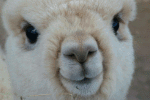Articles by Alpaca World Magazine:
The Alpaca Brand – Fact or Fiction?
Maggie Krieger
The first alpacas that were brought out of South America for the purpose of establishing a world wide industry were for the most part Chilean animals. Peru's alpaca stock resources were not tapped until more recently when the establishment of stringent quarantine protocols made the export of alpacas from Peru feasible. Establishment of quarantine facilities that could handle lengthy quarantine periods of up to one year was the final step in obtaining Peruvian alpaca genetics. Stringent quarantine was made necessary because of the foot and mouth disease status of Peru.
Once the Peruvian style animals arrived in the U.S. great efforts were made to market them and major marketing programs initiated the ignorant in the now well known names of certain Peruvian breeders. Names such as Accoyo, Don Julio Barreda, Rural Alianza, and Macusanie began to become well known. Then the controversy started. Questions were bandied about concerning quality and what was the difference between Peruvian and Chilean? Where does the Bolivian alpaca fit in terms of quality? How come the Chileans seem to have less dense fleece? Etc, etc, etc.
Advertising took a turn and the words Peruvian and Bolivian became commonplace while Chilean disappeared from glossy view. So, what does it all mean in the whole spectrum of the alpaca world?
My perspective is somewhat biased by the fact that I see a tremendous number of alpacas in the show ring. But my belief is that we have three different brands of alpaca here each with their own packages of genetic material that can be used in creating our very own individual style of alpacas. I perceive it as having the best of all three worlds with the potential to improve our stock for the future endeavours of the alpaca industry. Hence I feel that we should never combine white and coloured animals in our show classes since it puts the coloured alpaca at a distinct disadvantage.
On my travels around Peru over the years I have noted huge numbers of white alpacas which have ranged from large numbers of excellent quality animals with few poor quality scattered amongst them. These have been representative of the large co-operatively owned herds which are raised for fibre production. Then there are the herds that are owned by several families of an individual village, but they are managed in a co-operative style, with each owner sharing the pasturing and shearing work load. These alpacas would be of mixed colour types with generally more colour than white amongst them and the quality represented would be mediocre with more lower end quality. The most striking impression one has in this environment is that there are few high quality coloured alpacas but many excellent quality white alpacas.
This phenomenon, I am told, is attributable to the fact that the Mills, for many years in the past, paid premium price for white quality alpaca fleece because it could be dyed any colour demanded by the fashion industry. Latterly this is a concept that has been much regretted since the perfection of genetics has been concentrated more in the white animals than the coloured.
Having not travelled in Chile or Bolivia I cannot say what the status of alpaca quality observed in the countryside would be. However extrapolating from the representation in North America, we see tremendous colour genetics represented in both Chilean and Bolivian stock.
Now, what do I mean by high and low quality you may ask yourself? Well in deciphering high quality in an alpaca we would look for the following:
Excellent conformation with straight legs, straight back, correct proportioning and correct movement.
The correct shape to the ear, denoting alpaca type - spear shaped ears.
Fine, dense, crimpy fibre in the huacaya and fine, dense, lustrous fleece in the suri. Both types should have high production weights.
Fully functioning and adequately sized reproductive organs.
Correct bite with the teeth meeting the dental pad at the front in the correct manner.
Another factor that comes into play in terms of alpacas representative of any of these three countries is the situation with the border lines of each of these areas. These are three countries that occupy the vast plains of the Altiplano and in the more remote areas where there is no policing of the borders, it is thought that many of the outlying farms do not distinguish between where one or the other border begins or ends. If animals are selected for import from far and wide, how can we identify which farms they have been gathered from and to which country they belong. Hence the term 'Northern Chilean' or 'Northern Bolivian' - being interpreted as 'Peruvian'. These animals so labelled are actually from Peru but have been picked up in Bolivia or Chile! Generally these are exceptionally good quality alpacas.
Similarly, another influence that has come to bare in the movement of top quality alpacas out of Peru has been the fact that Peru is not recognised as a foot and mouth disease free country. So to label an animal Chilean is to enable it to be exported to other countries because Chile has F.M.D. free status. Another incentive to move Peruvian stock over the invisible border in the Altiplano.
In conclusion I feel it is fair to say that top quality Peruvian animals (those that are truly Peruvian in origin) generally do well in the show situation because their overall fleece quality is so much more advanced in genetic development than any other coloured stock. History shows us that this group have been genetically engineered for centuries to produce the desired high fibre production alpaca. However there is still some distance to go to bring coloured stock up to the same genetically evolved production and quality level. But there are also a great many very fine-fleeced coloured Chilean alpacas that because they carry the colour genetics are worth their weight in gold.
Further centuries of careful genetic engineering, using the colour palate of the Chileans and Bolivians and the quality of the white Peruvians, I believe, will provide the ultimate in high quality coloured alpacas. The race is on to see which country comes up with them first! Let us not write off one brand over the other, forsaking the incredible potential we have been lucky enough to be blessed with and privileged enough to own. With careful management of show rules and group classifications and the future of this industry in mind, there should be a place for every colour, type and brand of alpaca with equal competition for all.
Tweet



